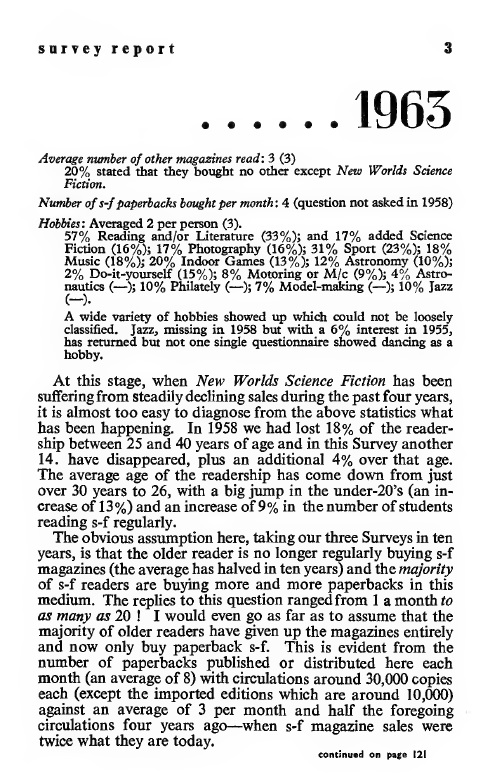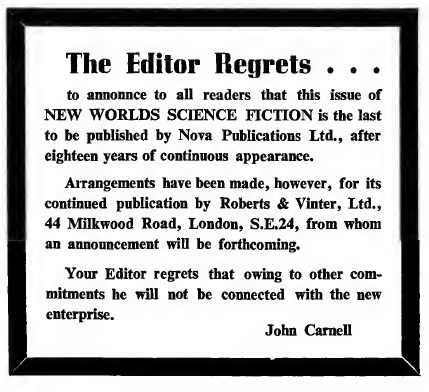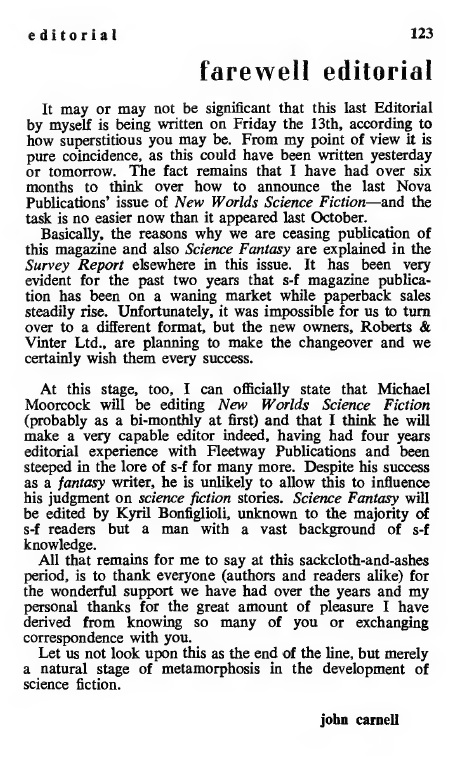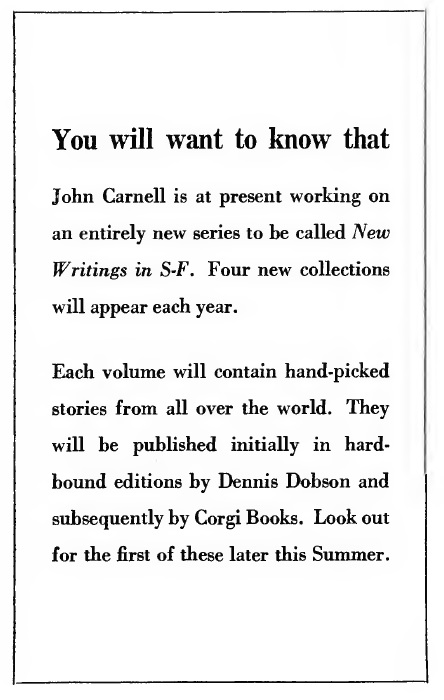
by Victoria Silverwolf
Opening Ceremonies
Howdy, sports fans!
Baseball season just opened up here in the good old USA. The New York Mets, relative newcomers to the sport, faced the Pittsburgh Pirates in the first game held at Shea Stadium, their new stomping grounds.

The first day, and already the scoreboard is broken
The Mets lost, 4 to 3. I know the young team has a pretty bad win-loss record, but that's got to hurt. Opening day at your brand new stadium and the visitors beat you by one run.
Like a baseball team, the latest issue of World of Tomorrow features nine men. (No women.) I'm counting editor Frederik Pohl as one of the players, as well as the coach and manager, since he provides the magazine's editorial — it's an interesting essay about C. P. Snow's book The Two Cultures and a Second Look, and how science fiction can build a bridge between science and the humanities. After he provides a few practice swings, let's get down to the real ballgame.
Batter Up!

cover by Gray Morrow
On Messenger Mountain, by Gordon R. Dickson
A reliable player steps up to the plate with a tale of war and survival in deep space.
The men (no women) of the starship Harrier are having a really bad day. After discovering an Earth-like planet, they run into an alien vessel. In this dog-eat-dog picture of the future, the two ships immediately try to destroy each other. Many men and aliens die, and both vessels have to make crash landings.

by Gray Morrow
The few human survivors find themselves at the foot of a gigantic mountain. One of the aliens attacks them right away. They manage to kill it, but not without more casualties. The aliens are able to alter their body structures rapidly to accommodate changing conditions.
As if that were not enough of a threat, the men have no way to signal for help without carrying a piece of equipment to the top of the mountain. Three of the crew set out on a long, difficult, and hazardous climb. Adding to their woes is the fact that there may be another alien alive, and it might be able to disguise itself as a human being.
Dickson creates a great deal of tension and suspense. The mountain climbing scenes are vivid and full of realistic details. The icy environment and shapeshifting aliens remind me of the classic story Who Goes There? by John W. Campbell, Jr. (but not The Thing From Another World, the movie loosely based on the story.) Dickson's aliens are described in more detail than Campbell's, and their ability to change their bodies is believable.
I could quibble with the assumption that first contact with aliens must inevitably lead to conflict, or with the story's ending, which promotes humanity as unique and superior. These aspects of the story make it seem intended for the pages of Analog. Overall, however, it's a very good adventure story.
Four stars.
The Twerlik, by Jack Sharkey
Batting second is a player who often strikes out, particularly when he's trying to be funny. Sometimes he connects with the ball solidly, when he takes off his jester's cap and gets down to serious business.
The Twerlik is a very strange alien. Its flat, monomolecular, multifilamented body extends over an area of ten square miles, but it only weighs one pound. It survives on its cold, dark world by absorbing light from the planet's distant sun. Humans arrive, bringing sources of light far greater than anything the Twerlik has ever known. Grateful for the gift of energy from the strangers, and for all the new concepts it learns from them, it gives them what they most desire.
Although the themes of be careful what you wish for and the road to Hell is paved with good intentions have been used many times before, Sharkey handles them in a new way. The alien is fascinating, particularly in the way it picks up novel ideas from the humans.
There's a small hole in the plot logic. The alien does not even have the concept of self until people show up. Why, then, does it think of itself as a Twerlik after they arrive? The humans don't call it that, or even know that it exists.
Despite this tiny flaw, this is the best story by Jack Sharkey that I have ever read.
Four stars.
Short Course in Button Pushing, by Joseph Wesley
Instead of a seventh inning stretch, we get a break from fiction with this article from a writer who has published a handful of stories, mostly in Galaxy. It starts off with a question that seems simple enough.
What is the range of one of our latest supersonic anti-air warfare Naval missiles?
The author goes on to show how a large number of variables make this impossible to answer. Atmospheric conditions, the nature of the target; the factors involved are incalculable. The article has a single point to make, and does it in an efficient, if not intriguing, manner.
Three stars.
Stay Out of Our Time!, by Willard Marsh

by Nodel
Back to the game with this satiric, semi-comic time travel story.
Hiram Wetherbee is a meek little fellow living in the late Twentieth Century. In his time, it's as easy to visit the far future or the distant past as it is to take a trip to a vacation spot. However, certain future centuries ban visitors from the past, blaming them for the way they ruined the future. Hiram, a painter of mediocre talent, intends to travel to 1902, in order to impress the unsophisticated locals with modern art. (His real motive is to seduce the women of the time, as he's not exactly a big success with the ladies.) A mix-up lands him in one of the forbidden centuries of the future, without enough funds to make his way back. After some misadventures with the authorities, he gets a guided tour of the time from some friendly folks who find him a remarkable specimen.
I was never quite clear what the author was trying to say, in this portrait of a future without imagination. Very few people have jobs. Euthanasia is encouraged. Abstract art flourishes, but realism is dead. Hiram talks in clichés, and the people of the future think he's brilliant. The story is readable, but wanders all over the place and never quite grabs the reader.
Two stars.
Lucifer, by Roger Zelazny
Next in the batting order is a player who is making a name for himself in the writing game.
A man returns to a city that lost all its inhabitants in some unexplained disaster. He goes into the vast building that provided its power and restarts the generators.
That's the entire plot of this story, which has only one character. Obviously, the author isn't going for pulse-pounding action. It's all mood, description, and psychological insight. On that level, it works very well.
Four stars.
The Great Doomed Ship, by J. T. McIntosh

by Gaughan
Up to the plate comes an old pro with a checkered career. Although he always swings hard at the ball, he rarely sends it flying over the wall.
The biggest and fastest starship ever built is about to set out on her maiden voyage. Because it is scheduled to leave exactly two hundred years after the Titanic disaster, some people think it is doomed.
There are other reasons to worry. This is a time when some folks have premonitions about the future, although these are not always reliable. A few people have vague feelings of impending disaster about the planned voyage. Most troubling of all, the designer of the vessel is in a mental institution, having gone into a catatonic state. Our hero, an investigator with some psychic ability, finds out that the mad engineer deliberately set the ship to blow up when it reaches a certain speed. He fails to prevent the vessel from taking off, and there is no way to communicate with it. Complicating matters is the fact that the investigator's sister, who also has extrasensory powers, is aboard.
As I was reading this story, I kept picturing it as a big budget Hollywood spectacular, in Technicolor and Cinemascope. The characters all come from Central Casting. Besides the hero, his sister, and the madman, we've got the stubborn head of the starship company; the hard-drinking co-designer of the ship; the sister's no-good boyfriend; the brave young captain of the vessel, who wins the affections of the sister; and so on.
I have problems with some of the things McIntosh says about women in his stories, yet, paradoxically, he creates complex female characters who are often more capable than the men are. The sister is a prime example. Although she's in a destructive relationship with a faithless lover, her weaknesses never prevent her from winning the reader's sympathy.
This cinematic epic was enjoyable, if hardly profound, until the end. It falls completely apart, with an anticlimax that depends on a trivial change in the meaning of a certain premonition the sister has about her fate.
Two stars.
The Realized Man, by Norman Spinrad
Here's a rookie with only a few credits to his name. Is he ready for the big league, or should he go back to the minors? Let's find out.
Derek Carmody is a man who has been mentally and physically enhanced to an extraordinary degree. His purpose is to arrive alone, without special equipment, on a planet inhabited by primitive aliens, and prepare them for later human colonists. He does this by becoming chief of the local tribe and offering them technological advantages over their rivals. It all leads up to a final gesture that will make him a god in the eyes of the natives.
Although the way in which the protagonist uses his superpowers is quite interesting, the story suffers from a lack of suspense. The author tells you in advance what the character is going to do at the end, and then he does it. I was a little disappointed that the confident superman didn't get his comeuppance.
Three stars.
What the Dead Men Say, by Philip K. Dick

by Virgil Finlay
We go into the final inning with a novella from a prolific, award-winning, but sometimes controversial author.
Louis Sarapis may be the richest person in the solar system. So rich, in fact, that not even the tax collectors know how much he's worth. He is also dead.
In this future, that's not a huge handicap. By keeping the recently deceased extremely cold, it's possible to temporarily preserve a low level of brain activity. The so-called half-lifers can communicate with the living, albeit in a limited way.
Attempts to revive the mind of the dead man fail, for unknown reasons. That would seem to be the end of the matter, except for one thing: messages that seem to be coming from the deceased arrive on Earth from deep in space. Eventually they take over all forms of electronic communication. You can't listen to the radio, watch television, or pick up the phone without hearing the dead man's voice.
The deceased's heir is his granddaughter, formerly a drug addict. Because her grandfather is legally dead, although apparently quite active, she now runs his vast business empire. She follows his orders from beyond the grave. In particular, she promotes the political career of a politician who formerly failed to become President of the United States, convinced he can make a comeback and win the office.
There is much more to this long and complex story than I've indicated. Many subplots appear, along with a wide variety of richly defined characters. The author avoids his tendency to have disparate elements, not fully integrated, in his works. The plotting is tight, with all of the seemingly mystical elements explained in a logical way.
(One trivial observation remains. In passing, the story states that Richard Nixon revived his political career in the 1970's. I know science fiction writers are supposed to come up with wild speculations, but that's really stretching things.)
Five stars.
The Box Score
Coach Pohl puts his big hitters at the front and back of the magazine, making up for a slight slump in the middle. With all bases loaded in the bottom of the ninth, slugger Philip K. Dick hits a home run. It makes you want to root for the underdogs. Go Mets!

[Come join us at Portal 55, Galactic Journey's real-time lounge! Talk about your favorite SFF, chat with the Traveler and co., relax, sit a spell…]

![[April 20, 1964] Play Ball! (June 1964 <i>Worlds of Tomorrow</i>)](https://i0.wp.com/galacticjourney.org/wordpress/wp-content/uploads/2019/04/640420cover.jpg?resize=672%2C372&ssl=1)

![[April 18, 1964] A firm line (the May 1964 <i>Fantasy and Science Fiction</i>)](https://i0.wp.com/galacticjourney.org/wordpress/wp-content/uploads/2019/04/640418cover-1.jpg?resize=672%2C372&ssl=1)





![[April 16, 1964] Of Houses and World Building (Jack Vance's The Houses of Iszm/ Son of the Tree and Andre Norton's Web of the Witch World)](https://i0.wp.com/galacticjourney.org/wordpress/wp-content/uploads/2019/04/640416double.jpg?resize=640%2C372&ssl=1)








![[April 14, 1964] COOKING WITH ASH (the May 1964 <i>Amazing</i>)](https://i0.wp.com/galacticjourney.org/wordpress/wp-content/uploads/2019/04/640414cover.jpg?resize=672%2C372&ssl=1)








![[April 8th, 1964] Pooooolo! (<i>Doctor Who</i>: Marco Polo, Parts 5 to 7)](https://i0.wp.com/galacticjourney.org/wordpress/wp-content/uploads/2019/04/640408costumes.jpg?resize=672%2C372&ssl=1)












![[Apr. 6, 1964] The art of word-smithing (May 1964 <i>IF</i>)](https://i0.wp.com/galacticjourney.org/wordpress/wp-content/uploads/2019/04/640406cover.jpg?resize=672%2C372&ssl=1)





![[Apr. 4, 1964] A taste of brine (the book and movie, <i>The Amphibian</i>)](https://i0.wp.com/galacticjourney.org/wordpress/wp-content/uploads/2019/04/640403AM_1.jpg?resize=672%2C372&ssl=1)








![[Apr. 2, 1964] The Joke's on me (the uninspiring April 1964 <i>Analog</i>)](https://i0.wp.com/galacticjourney.org/wordpress/wp-content/uploads/2019/04/640402cover.jpg?resize=672%2C372&ssl=1)














![[March 29, 1964] Five by Five (March Galactoscope)](https://i0.wp.com/galacticjourney.org/wordpress/wp-content/uploads/2019/03/640329marooned-1.jpg?resize=417%2C372&ssl=1)






![[March 27, 1964] The End of an Era? Not With a Bang…. ( <i>New Worlds, April 1964</i>)](https://i0.wp.com/galacticjourney.org/wordpress/wp-content/uploads/2019/03/640327cover.jpg?resize=409%2C372&ssl=1)





